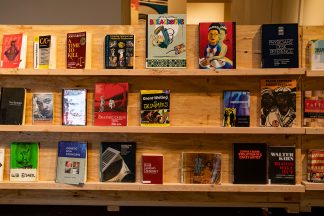By Mark Engebretson

Betsy Friesen, Daniel McCarthy-Clifford, and Boris Oicherman holding books that have been banned at prisons across the United States.
Why would a prison ban a book about Chicano art? Or military history? Or computer programming? Or an autobiography of Malcolm X?
After all, such books are readily available to anyone not in prison for purchase or through one’s public or academic library.
Visual artist Daniel McCarthy Clifford has his own theories, and he’s doing additional research and using his art to raise awareness of what seems to be an arbitrary process of deciding what can and can’t be read by inmates in prisons across our nation.
“It’s injustice,” he says. “History is being withheld [from inmates].”
Raising awareness through his art
Clifford — an artist in residence at Weisman Art Museum’s Target Studio for Creative Collaboration — is raising awareness, in part, through a current exhibit at the Weisman, The Section of Disapproved Books. The exhibit is curated by Weisman’s Boris Oicherman, and it uses materials and research provided by the University Libraries.
Weisman staff member, Ray Barney, acquired and formatted lists of banned books from 22 state correctional departments. Libraries’ staff members Betsy Friesen, Michael Johnson, Kate McManus, Cassia Brand, Gennie Kieffer and student staff Nikole George,Yasmin Hussein, Anna Clough, deduplicated the list, analyzed the data, and searched many of the nearly 16,000 titles against the Libraries’ catalog. Over 600 volumes, from across the campus, make up the exhibit.
“The lists themselves are really interesting as to what prisons choose to ban,” says Betsy Friesen, Director of Data Management & Access at the Libraries. Some state lists had thousands of titles while others had a few dozen. The journal issues most often banned were from Playboy, Popular Mechanics, and Rolling Stone. Tao of Jeet Kune by Bruce Lee and The Cartel by Ashley & JaQuavis were the books most commonly disallowed. One author, Robert Greene, had all his books banned at correctional facilities in New Hampshire and New Jersey.
“There weren’t that many titles banned by more than one state,” says Friesen, whose goal 40 years ago was to be a prison librarian.When looking at the lists Friesen said, “Anecdotally, I would say that there’s an awful lot of literature that’s being banned. Things that have to do with social justice, … sociology, particularly criminal justice.” This observation was borne out by the titles pulled from the Libraries’ collections. Over 100 titles would be categorized as social and public welfare and criminology topics, while another 100 were American literature. Other Libraries’ titles fall into the life sciences, American history, law, medicine and science and technology areas.
Banned books include Windows 7 manual, Joyce’s ‘Ulysses’
“A Windows 7 manual is on one state’s list. Why?” she asks. “There is no one standard. … It was just arbitrary. That was one of the points that we were trying to make, to show how arbitrary these lists are, and why? What’s the point?”
“Somebody wants to send a book to a loved one in prison and somebody in the mail room of that prison receives the book and needs to make the decision whether it goes in or not,” says Oicherman. “I saw an Haggadah disapproved in the state of Washington. This is a book that you read with kids on Passover, if you’re Jewish.”
Clifford says he believes the arbitrary nature of screening stems from a desire by prison administrators to ensure that inmates can’t organize. But on a practical level, he says, the screening of books is done by guards with little training and few defined standards for prison employees to follow when deciding whether or not a book is banned.
“These guards aren’t sitting there thinking, we need to stop an insurrection,” says Clifford. “You know, they’re sitting there saying, okay this book has a nipple in it. … They are talking about a prison strike in this book. We’re gonna ban it.”
Oicherman agrees. “Is a painting that has an exposed breast pornography or is it art?” he asks. “Is an autobiography of Malcolm X a threat to security? Somebody decided it is.”
Exhibit is part of Clifford’s Leavenworth research project
Oicherman, hired in this past year as the Weisman’s first Cindy and Jay Ihlenfeld Curator for Creative Collaborations, hopes to foster collaborations and conversations on campus through his work at the Weisman.
“For example, with Danny’s project, the exhibit supports his activity to develop further projects and further relationships,” Oicherman says. “He has already met with more than 20 people in the University community and has had conversations on different aspects of imprisonment, criminal justice, and prison labor.”
Betsy is ‘an angel’
Clifford calls Friesen “an angel” and adds that the exhibit could not have happened without the Libraries’ help.
“They made it possible. They’ve been like 100 percent the only way this has gone forward,” he says. “Betsy is so dedicated to this project. It’s scary.”
Oicherman, Friesen, and Clifford all say that the exhibit brings the issues home to just about anyone.
“Once you see James Joyce’s Ulysses [in the banned book collection] — a book that may have had a big impact on you growing up, or that you read in school — that can, like, change everything,” Cifford says. “Then you might have a dog in the fight.”





